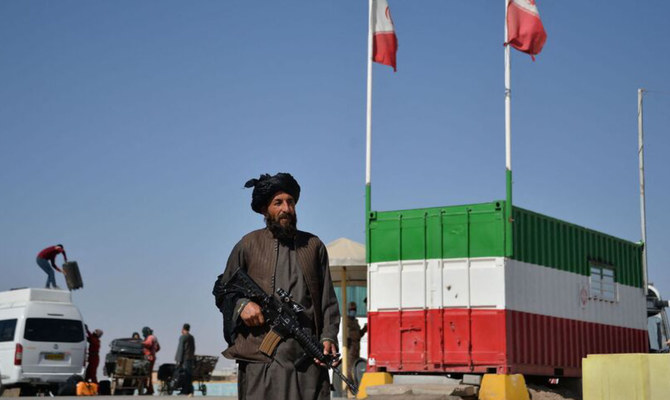
- ARAB NEWS
- 05 Jul 2025

Over the past few months, Iran realized that the Taliban would be much more assertive in their future bilateral dealings. For any observer, Kabul’s tough-talking approach seems consistent considering its conduct with Islamabad. Tehran’s loss of patience with the Taliban reflects the over-estimation of its influence.
Recent armed clashes along the Helmand-Baluchistan border have inflicted several fatalities, with at least two confirmed losses of soldiers on the Iranian side and one on the Afghan side. The fierce fighting involved automatic machine guns, artillery and rocket fire, while Iran even resorted to the use of gunship helicopters and drones. The Taliban took over at least one Iranian border post before vacating it later, on the order of senior officials.
Iran’s media estimates that more than 50 Iranians, military, and civilian personnel, have lost their lives to sporadic clashes along the Afghan border since 2020. The fresh battle resulted in Iran dispatching its senior commanders — Deputy Chief of Iran’s Law Enforcement Forces Brig. Gen. Qasem Rezaei and Chief of the Iranian Army’s Ground Forces Brig. Gen. Kioumars Heydari — to Sistan-Baluchistan, which borders Afghanistan’s Nimruz province. Iran closed the Milak-Zaranj border crossing post, not the site of the clashes, which is a key channel for commerce between the two sides.
Though Iran claimed that its border guards fired at smugglers infiltrating from the Afghan side, a source of tensions and clashes over the decades, the reality lies in Tehran’s continuous quest for water resources. Afghanistan has constructed dams on the Helmand River in recent years — the last of which, Kamal Khan Dam, was inaugurated by President Ashraf Ghani ahead of the US troop withdrawal in 2021. Tehran registered its formal concerns at the diplomatic level as well as through its official spokespersons. These concerns were heightened considering Kabul’s tough stance and fiery rhetoric. At the inauguration of the dam in March 2021, Ghani said: “Afghanistan would no longer give free water to anyone, so Iran should provide fuel to Afghans in exchange for water.”
As per the 1973 Helmand Water Treaty, Afghanistan agreed to release the Helmand River water at a rate of 22 cubic meters per second per annum with an additional four cubic meters per second for “goodwill and brotherly relations.” When entering Iran, the Helmand River flows through its harshest arid regions in the south.
On May 18, Iranian President Ebrahim Raisi said during his visit to Sistan-Baluchistan that the rulers of Afghanistan should “not regard our demand as being ordinary and must take it very seriously.” There are diplomatic contacts between both neighbors, but Tehran has yet to formally recognize the Taliban government.
From Tehran’s perspective, the Taliban is not what it used to be when its eight diplomats were murdered in Herat prior to 9/11. Thanks to years of material and financial support, as well as the provision of refuge, the Taliban’s leadership adopted a more pragmatic approach toward Iran, if not deeply friendly.
As one of the top water-stressed countries, Iran is already too late in taking mitigation measures.
Dr. Mohammed Al-Sulami
Two decades later, the Taliban allowed Ashura processions in Afghanistan, delivered sermons there and eventually appointed a couple of Shiite ministers and advisers. Afghan Shiite clerics opted for a wait-and-see approach. Only recently, Afghan Shiites have started to grow impatient with the Taliban, in sync with Iran’s soaring unease and changing tone toward Kabul.
As one of the top water-stressed countries, Iran is already too late in taking mitigation measures. Climate change adaption has not been on its busy agenda in comparison with its neighbors such as Turkiye and Pakistan.
Is Iran really accurate in claiming that Afghanistan has been denying its rightful share of the Helmand River’s water? The treaty signed in 1973 between the two states did not foresee the climate scenarios ahead as well as the needs of Afghanistan.
Similarly, the Taliban disagree on everything with their US-backed predecessors except the water-sharing deal with Iran. The 1973 treaty requires Afghanistan to deliver water from the Helmand River to Iran at a rate of 22 cubic meters per second per annum, which equals to an annual average of 820 million cubic meters. The treaty’s Article V authorizes Kabul full rights to the remaining water supply by stating that Afghanistan “shall retain all rights to the balance of the water of the Helmand River and may make such use or disposition of the water as it chooses.”
Though the last section of the article limits Iran’s entitlement of water to 820 mcm (as specified in the treaty), it did not foresee the situation of persisting drought and increased use by the Afghan population. Iran has been receiving water far in excess of the agreed amount most of the time due to the conflict in the country from the late 1970s until the Kamal Khan Dam became operational in 2021, which is permitted under the Helmand River Treaty. International law is also on Afghanistan’s side. Kabul was too bogged down in internal strife to exercise its right over the past four decades.
Afghanistan’s construction of the dam may be a source of Tehran’s fury, but in reality there are not enough hydrometric stations to measure the water flow from Afghanistan to Iran. Both neighbors need to jointly determine the sites for the construction of joint hydrometric stations as per the treaty.
Interestingly, Tehran opposes joint hydrometric stations while still vehemently complaining of reduced water supplies. If an amicable solution is not reached, Tehran may make its veiled threat of destroying the dam a reality. Afghans will consider it a declaration of war. Tehran’s relations may have thawed with its Gulf neighbors, but it can’t afford a fresh front while it also wrestles to manage the situation on the Azeri border in the northwest.
• Dr. Mohammed Al-Sulami is president of the International Institute for Iranian Studies (Rasanah).
Twitter: @mohalsulami